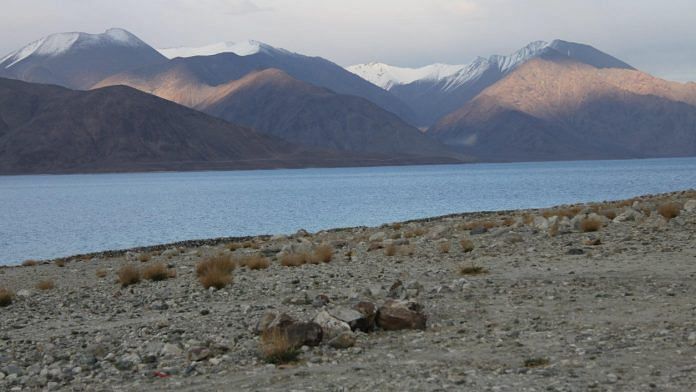New Delhi: The tensions at the Line of Actual Control (LAC) in Galwan Valley began in April, and China moved 5,000 additional troops to Pangong Lake the next month, China’s main public broadcaster has claimed.
This is the first Chinese acknowledgment about the number of troops mobilised in the Pangong Lake area amid tensions with India.
A report published Friday on the English language CGTN, formerly known as CCTV-9 and CCTV News and part of the state-owned China Media Group, sought to offer a timeline of the recent tensions between the two Asian giants in Ladakh at multiple points, including Pangong Lake and Galwan Valley.
According to the report, it was in April that Indian troops built “facilities along the LAC in the Galwan Valley”, after which China registered “protests”.
As reported earlier by ThePrint, Chinese aggression at the border is aimed at restraining India from carrying out any new construction beyond the confluence of the Shyok-Galwan river, which is about 5 km from the Line of Actual Control (LAC), in the Galwan Valley area. China, it is believed, wants to expand its territory by pushing the LAC further into Indian limits.
While the Chinese have objected to a 60-metre-long bridge over the Shyok river, which was completed by India during the stand-off last month, the real problem was “certain construction” being carried out by India beyond the confluence point.
“Although the two Asian giants are not strangers to border incidents, it was the first time in decades that the border dispute turned deadly,” CGTN said in its report, referring to the 15 June Galwan Valley clashes.
The report is the first extensive account of the border tensions offered by the state broadcaster. So far, the daily Global Times has been leading reportage on the border tensions from the Chinese perspective.
Also Read: It’s time for China, Pakistan, even India to rethink the fantasy Modi called expansionism
Pushing into Indian territory
The report said the “first scuffle” between the two sides took place between 5 and 6 May at Pangong Tso in Ladakh, “during which soldiers from both sides were injured”.
It referred to a “second scuffle at Naku La in Sikkim” on 9 May and mentioned that China subsequently moved soldiers into the Pangong Lake area on 25 May. It is learnt from Indian defence sources that China diverted soldiers from an exercise being held near the LAC to carry out transgressions and troop build-up.
While CGTN gave the numbers of troops moved to Pangong, it was silent on the numbers in Galwan Valley, Hot Springs area, and Depsang Plains, which have all been sites of tensions along the western sector of the LAC.
At Pangong Lake, satellite images have established that the Chinese moved 8 km inside Indian territory and are sitting at Finger 4.
India believes the LAC starts at Finger 8, and it has been conducting foot patrols until this point. However, the Chinese have been known to conduct patrols until Finger 4.
Also Read: India’s options against China shrink to two — limited war or another Wuhan




Wait wait
Chinese mouthpieces have banned my account for the fiery tweet I gave it. Twitter also acts as a biased agent, when pakis abuse our religion and mother sita , twitter never bans them. Global times a trombone of china xi pi g pong is afraid of a tweet leave fighting the Indian army